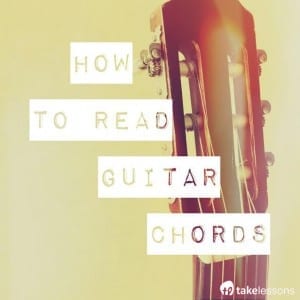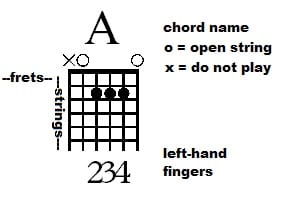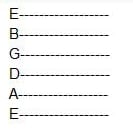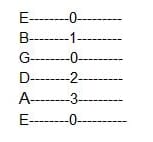 If you’re beginning to learn how to play guitar, chances are you’ll want to get started by learning a handful of chords. Learning how to read guitar chords is a great way to get familiar with guitar notation and get used to your instrument.
If you’re beginning to learn how to play guitar, chances are you’ll want to get started by learning a handful of chords. Learning how to read guitar chords is a great way to get familiar with guitar notation and get used to your instrument.
A chord is a group of notes that makes a harmony when played all together. On guitar, you can strum chords to accompany a melody that you or someone else are singing, or more advanced players might incorporate chords with single notes for a more complex sound. Basically, chords are the building blocks you need to have in place in order to learn to play songs on the guitar.
How to Read Guitar Chord Charts
 Guitar chords can be written in a couple of different ways, so don’t worry if you don’t yet know how to read guitar tabs or sheet music. Guitar chord charts, like the one on the left, are easy to read once you learn a few basics.
Guitar chords can be written in a couple of different ways, so don’t worry if you don’t yet know how to read guitar tabs or sheet music. Guitar chord charts, like the one on the left, are easy to read once you learn a few basics.
Think of guitar chord charts as a graphic representation of the fingerboard of your guitar. The horizontal line at the top of the guitar chord chart is the nut of your guitar, the piece at the top where the head meets the fingerboard. Below the nut, each horizontal line represents another fret, which are the wire dividers on the fretboard.
The six vertical lines each represent a string, from left to right EADGBE. If you are holding your guitar like you are ready to play, the thickest string, low E, is the string that is closest to the top. As you strum downward, you will hit the A, D, G, B, and last the high E.
On this diagram, the three black dots indicate that you will need to press down three strings – the D, G, and B strings – on the second fret. The numbers at the bottom of the chart tell you which fingers on your left hand you should use to hold down the strings. Your left hand fingers are numbered one through four, starting with your index finger.
So let’s break down exactly how this chart is showing you to play the A chord. Put your middle finger on the second fret of the D string, your ring finger on the second fret of the G string, and your pinkie on the second fret of the B string. Be mindful to press with just the tips of your fingers so you do not muffle or mute any strings. Strum slowly from the A string down one note at a time to make sure you are fretting each note cleanly and clearly. Congratulations, you just played an A chord!
Here are a few more guitar chord charts for you to practice reading:

Feeling pretty good about reading guitar chord charts? Awesome! Let’s take a look at another way to read guitar chords: guitar tabs.
What are Guitar Tabs?
 Guitar tabs have six horizontal lines, one for each of the six strings of your guitar. The top line always corresponds with your high E (or first) string and the bottom line always corresponds to your low E (or sixth) string.
Guitar tabs have six horizontal lines, one for each of the six strings of your guitar. The top line always corresponds with your high E (or first) string and the bottom line always corresponds to your low E (or sixth) string.
The layout of tablature can be a little tricky at first, since it’s basically upside down when compared to the actual neck of your guitar. However, this arrangement actually mimics sheet music by representing higher notes higher on the staff than low notes, so if you plan to go on to read sheet music, it’s helpful to get used to seeing the higher notes higher.
Numbers will be written on the strings to let you know which fret to play. For example, if a song calls for you to play the 5th fret on the A string, you will see a number 5 on the second line up from the bottom. If you see a zero, play the string “open,” without holding down a fret.
When reading guitar tabs, do so from left to right, like you would read a book. It’s important to note that guitar tabs indicate the sequence of the notes but don’t indicate the rhythm. Listen to the song you’re learning as you look at the tab to get a feel for the rhythm.
Unlike guitar chord charts, the numbers on tablature have nothing to do with the number of the finger on your left hand that you should use to hold down the fret. The numbers only refer to the fret where the string should be held down. If you’re getting stuck on fingering for a particular guitar tab, you might want to consult with a guitar teacher for help.
Now that you know the basics of how to read guitar tabs, let’s look at reading chords.
How to Read Guitar Chords in Tabs
 Chords in guitar tabs are shown as in the diagram at the left, with all the notes stacked on top of one another. Remember, guitar tabs read from left to right, and the note spacing indicates sequence. Stacking the notes means they are played at the same time, and as you know, notes that are played together to produce a harmony make a chord.
Chords in guitar tabs are shown as in the diagram at the left, with all the notes stacked on top of one another. Remember, guitar tabs read from left to right, and the note spacing indicates sequence. Stacking the notes means they are played at the same time, and as you know, notes that are played together to produce a harmony make a chord.
Based on the guitar chord charts you practiced earlier, can you name the chord shown in the diagram? If you said “C”, you are correct!
Now that you know how to read guitar chords in charts and tablature, start practicing your chords and learning songs! There are many songs that can be played using simple, common guitar chord progressions. Once you’ve mastered these chord progressions, you’ll find that your musical repertoire will grow exponentially!
For more help learning how to play guitar, taking private lessons from a guitar teacher is a great way to get personal attention. A great teacher will be able to spot your mistakes and show you how to improve. Find your perfect guitar teacher today!
Megan L.
